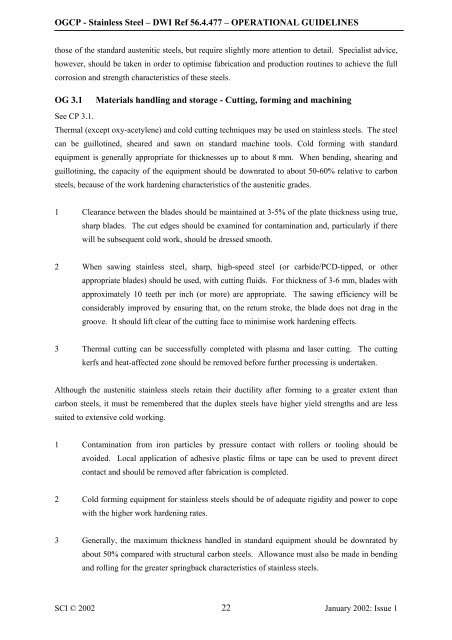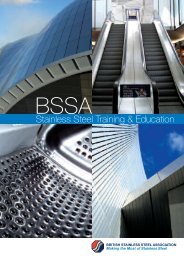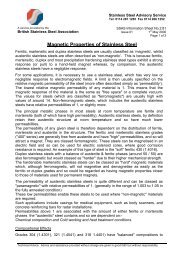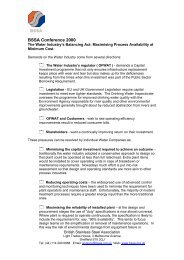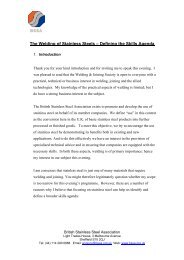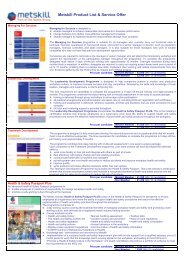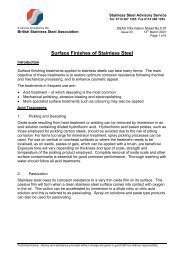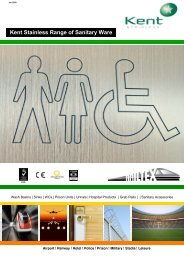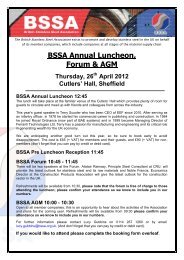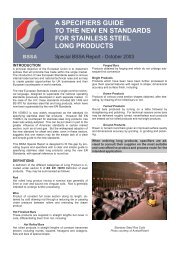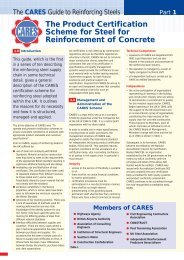Operational guidelines and code of practice for stainless steel
Operational guidelines and code of practice for stainless steel
Operational guidelines and code of practice for stainless steel
You also want an ePaper? Increase the reach of your titles
YUMPU automatically turns print PDFs into web optimized ePapers that Google loves.
OGCP - Stainless Steel – DWI Ref 56.4.477 – OPERATIONAL GUIDELINES<br />
those <strong>of</strong> the st<strong>and</strong>ard austenitic <strong>steel</strong>s, but require slightly more attention to detail. Specialist advice,<br />
however, should be taken in order to optimise fabrication <strong>and</strong> production routines to achieve the full<br />
corrosion <strong>and</strong> strength characteristics <strong>of</strong> these <strong>steel</strong>s.<br />
OG 3.1 Materials h<strong>and</strong>ling <strong>and</strong> storage - Cutting, <strong>for</strong>ming <strong>and</strong> machining<br />
See CP 3.1.<br />
Thermal (except oxy-acetylene) <strong>and</strong> cold cutting techniques may be used on <strong>stainless</strong> <strong>steel</strong>s. The <strong>steel</strong><br />
can be guillotined, sheared <strong>and</strong> sawn on st<strong>and</strong>ard machine tools. Cold <strong>for</strong>ming with st<strong>and</strong>ard<br />
equipment is generally appropriate <strong>for</strong> thicknesses up to about 8 mm. When bending, shearing <strong>and</strong><br />
guillotining, the capacity <strong>of</strong> the equipment should be downrated to about 50-60% relative to carbon<br />
<strong>steel</strong>s, because <strong>of</strong> the work hardening characteristics <strong>of</strong> the austenitic grades.<br />
1 Clearance between the blades should be maintained at 3-5% <strong>of</strong> the plate thickness using true,<br />
sharp blades. The cut edges should be examined <strong>for</strong> contamination <strong>and</strong>, particularly if there<br />
will be subsequent cold work, should be dressed smooth.<br />
2 When sawing <strong>stainless</strong> <strong>steel</strong>, sharp, high-speed <strong>steel</strong> (or carbide/PCD-tipped, or other<br />
appropriate blades) should be used, with cutting fluids. For thickness <strong>of</strong> 3-6 mm, blades with<br />
approximately 10 teeth per inch (or more) are appropriate. The sawing efficiency will be<br />
considerably improved by ensuring that, on the return stroke, the blade does not drag in the<br />
groove. It should lift clear <strong>of</strong> the cutting face to minimise work hardening effects.<br />
3 Thermal cutting can be successfully completed with plasma <strong>and</strong> laser cutting. The cutting<br />
kerfs <strong>and</strong> heat-affected zone should be removed be<strong>for</strong>e further processing is undertaken.<br />
Although the austenitic <strong>stainless</strong> <strong>steel</strong>s retain their ductility after <strong>for</strong>ming to a greater extent than<br />
carbon <strong>steel</strong>s, it must be remembered that the duplex <strong>steel</strong>s have higher yield strengths <strong>and</strong> are less<br />
suited to extensive cold working.<br />
1 Contamination from iron particles by pressure contact with rollers or tooling should be<br />
avoided. Local application <strong>of</strong> adhesive plastic films or tape can be used to prevent direct<br />
contact <strong>and</strong> should be removed after fabrication is completed.<br />
2 Cold <strong>for</strong>ming equipment <strong>for</strong> <strong>stainless</strong> <strong>steel</strong>s should be <strong>of</strong> adequate rigidity <strong>and</strong> power to cope<br />
with the higher work hardening rates.<br />
3 Generally, the maximum thickness h<strong>and</strong>led in st<strong>and</strong>ard equipment should be downrated by<br />
about 50% compared with structural carbon <strong>steel</strong>s. Allowance must also be made in bending<br />
<strong>and</strong> rolling <strong>for</strong> the greater springback characteristics <strong>of</strong> <strong>stainless</strong> <strong>steel</strong>s.<br />
SCI © 2002 22<br />
January 2002: Issue 1


